Alternating Current
Question 1. The reactance of an inductance of 0.01 H at 50 Hz AC is
- 1.04 Ω
- 3.14 Ω
- 0.59 Ω
- 6.28 Ω
Answer: 2. 3.14 Ω
Inductive reactance is
XL = ωL = 2πfL
= 2(3.14)(50 s-1)(1.0 x 10-2 H) = 3.14 Ω

Question 2. In an AC circuit, an alternating voltage ε = 200√2 sin lOOt V is connected to a capacitor of capacitance 1 p, F. The rat value of the current in the circuit is
- 100 mA
- 200 mA
- 20 mA
- 10 mA
Answer: 3. 20 mA
The voltage of the AC source is
S = (200√2 V)sin l00t = ε0 sin ωt.
Capacitive reactance is
⇒ \(X_C=\frac{1}{\omega C}=\frac{1}{(100)\left(10^{-6} \mathrm{~F}\right)}=10^4 \Omega\)
Peak value of current = \(I_0=\frac{\varepsilon_0}{X_C}\)
∴ rms value of current is
∴ \(I_{\mathrm{rms}}=\frac{I_0}{\sqrt{2}}=\frac{1}{\sqrt{2}} \frac{\varepsilon_0}{X_{\mathrm{C}}}=\frac{200 \sqrt{2} \mathrm{~V}}{\sqrt{2}\left(10^4 \Omega\right)}=20 \times 10^{-3} \mathrm{~A}=20 \mathrm{~mA}\).
Question 3. An AC voltage is applied to resistance R and an inductor L in series. If R and the inductive reactance are both equal to 3 Ω, the phase difference between the applied voltage and the current in the circuit is
- \(\frac{\pi}{4}\)
- \(\frac{\pi}{2}\)
- Zero
- \(\frac{\pi}{6}\)
Answer: 1. \(\frac{\pi}{4}\)
In an LR circuit, the phase difference 0 between the current and the voltage is given by
⇒ \(\tan \theta=\frac{\text { reactance }}{\text { resistance }}=\frac{X_L}{R}=\frac{3 \Omega}{3 \Omega}=1=\tan 45^{\circ}\).
∴ phase difference = \(\theta=45^{\circ}=\frac{\pi}{4}\).
Question 4. A coil of self-inductance L is connected in series with a bulb B and an AC source. The brightness of the bulb decreases when
- The frequency of the AC source is decreased
- The number of turns in the coil is reduced
- A capacitor of reactance Xc = XL is included in the same circuit
- An iron rod is inserted into the coil as a core
Answer: 4. An iron rod is inserted into the coil as a core
The brightness of the bulb is due to current I flowing through it.
Current, \(I_0=\frac{V_0}{X_L}=\frac{V_0}{\omega L}\)
Brightness will decrease if ω and L increase. L can be increased by inserting an iron rod in the coil of self-inductance L as the core.
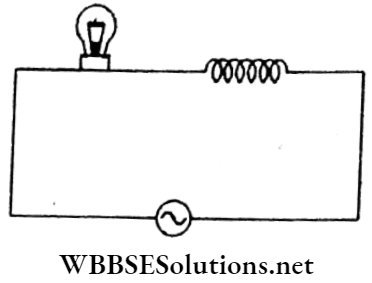
Question 5. A series RC circuit is connected to an alternating voltage source. Consider the following two situations.
- When the capacitor is air-filled
- When the capacitor is mica-filled
If the current through the resistor is I and the voltage across the capacitor is V then
- V1 < V2
- V1 > V2
- l1 > I2
- V1 = V2
Answer: 2. V1 > V2
The current amplitude in the series RC circuit is
⇒ \(I_0=\frac{V_0}{\sqrt{R^2+X_C^2}}\)
∴ the voltage across the capacitor is
⇒ \(V_{\mathrm{C}}=I_0 X_{\mathrm{C}}=\frac{V_0}{\sqrt{1+\frac{R^2}{X_C^2}}}=\frac{V_0}{\sqrt{1+\omega^2 C^2 R^2}}\)
- When the capacitor is air-filled, \(V_1=\frac{V_0}{\sqrt{1+\omega^2 C^2 R^2}}\)
- and when it is mica filled, \(V_2=\frac{V_0}{\sqrt{1+\omega^2 k^2 C^2 R^2}}\),
where K is the dielectric constant of mica.
Since K>1, therefore V1 > V2.
Question 6. In the given circuit, the readings of voltmeters V1 and V2 are 300 V each. The readings of the voltmeter V3 and ammeter A are respectively
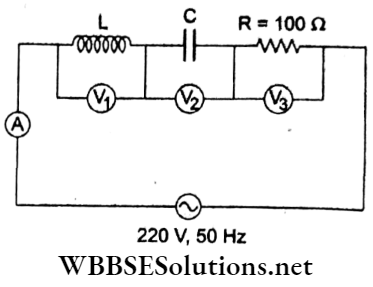
- 150 V, 2.2 A
- 220 V, 2.2 A
- 220 V, 2.0 A
- 100 V, 2.0 A
Answer: 2. 220 V, 2.2 A
Since the voltage across L and C are in opposite phases and have equal values, they cancel each other.
The current in the circuit is
⇒ \(I=\frac{V}{R}=\frac{220 \mathrm{~V}}{100 \Omega}=2.2 \mathrm{~A}\)
The potential drop across the resistor is
VR = IR = (2.2 A)(100 Ω) = 220 V.
reading of voltmeter V3 and ammeter A is 220 V and 2.2 A respectively.
Question 7. In a circuit, L, C, and R are connected in series with an alternating voltage source of frequency f. The current leads the voltage by 45°. The value of C is
- \(\frac{1}{2 \pi f(2 \pi f L-R)}\)
- \(\frac{1}{2 \pi f(2 \pi f L+R)}\)
- \(\frac{1}{\pi f(2 \pi f L+R)}\)
- \(\frac{1}{\pi f(2 \pi f L-R)}\)
Answer: 2. \(\frac{1}{2 \pi f(2 \pi f L+R)}\)
In the LCR circuit, the phase difference θ between the current and voltage is given by
⇒ \(\tan \theta=\frac{X_C-X_L}{R}=\tan 45^{\circ} \text { (given) }\)
∴ \(\mathrm{X}_{\mathrm{C}}-\mathrm{X}_{\mathrm{L}}=R \Rightarrow \mathrm{X}_{\mathrm{C}}=\frac{1}{2 \pi f C}=2 \pi f L+R \Rightarrow C=\frac{1}{2 \pi f(2 \pi f L+R)}\)
Question 8. An LCR series circuit is connected to an alternating voltage source. At resonance, the instantaneous voltage and the current through the circuit will have a phase difference of
- \(\frac{\pi}{2}\)
- π
- \(\frac{\pi}{4}\)
- Zero
Answer: 4. Zero
Peak current in the LCR circuit is
⇒ \(I_0=\frac{V_0}{\sqrt{R^2+\left(\omega L-\frac{1}{\omega C}\right)^2}}\)
At resonance as the circuit is purely resistive,
reactance \(X=\omega L-\frac{1}{\omega C}=0\)
and phase difference between the current and the voltage is given by
⇒ \(\tan \theta=\frac{X_L-X_C}{R}=0 \Rightarrow \theta=0\)
Hence, the phase difference is zero.
Question 9. In a series LCR circuit, the voltage across resistance, capacitance, and inductance is 10 V each. If the capacitor is short-circuited, the voltage across the inductance will be
- 20 V
- 10 V
- 10√2V
- \(\frac{10}{\sqrt{2}} \mathrm{~V}\)
Answer: 4. \(\frac{10}{\sqrt{2}} \mathrm{~V}\)
In the LCR series circuit,
VR = VL = VC = 10 V
⇒ IR = IXL = IXc = 10 V
⇒ R = XL = Xc
When the capacitor is short-circuited, the circuit becomes an LR circuit for which current,
⇒ \(I=\frac{V_0}{\sqrt{R^2+X_{\mathrm{L}}^2}}=\frac{V_0}{\sqrt{2 R^2}}=\frac{V_0}{R \sqrt{2}}=\frac{10}{R \sqrt{2}}\).
PD across the inductor is
∴ \(V_{\mathrm{L}}=I X_{\mathrm{L}}=I R=\frac{10}{\sqrt{2}} \mathrm{~V}\).
Question 10. In a given series LCR circuit, R = 4 Ω, XL = 5Ω, and Xc = 8 Ω. The current
- Leads the voltage by \(\tan ^{-1}\left(\frac{5}{8}\right)\)
- Leads the voltage by \(\tan ^{-1}\left(\frac{3}{4}\right)\)
- Lags the voltage by \(\tan ^{-1}\left(\frac{3}{4}\right)\)
- Lags the voltage by \(\tan ^{-1}\left(\frac{5}{8}\right)\)
Answer: 2. Leads the voltage by \(\tan ^{-1}\left(\frac{3}{4}\right)\)
Since Xc > XL, the current leads the voltage by an angle of θ. From the impedance triangle,
⇒ \(\tan \theta=\frac{X_C-X_L}{R}=\frac{8 \Omega-5 \Omega}{4 \Omega}=\frac{3}{4}\)
∴ \(\theta=\tan ^{-1}\left(\frac{3}{4}\right)\)
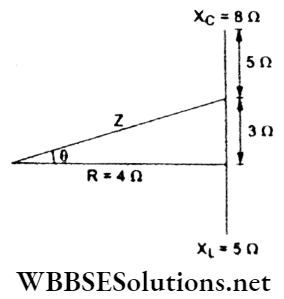
Question 11. In a series LCR circuit, the phase difference between the applied voltage and current is
- Positive when XL > Xc
- Positive when Xc > XL
- 90°
- 0°
Answer: 1. Positive when XL > Xc
In a series LCR circuit, the voltage leads the current when XL > Xc, so \(\tan \theta=\frac{X_L-X_C}{R}\) is positive
Question 12. An AC source of 20 V, 50 Hz is connected across R and C as shown in the figure. The voltage across R is 12 V. The voltage across C is
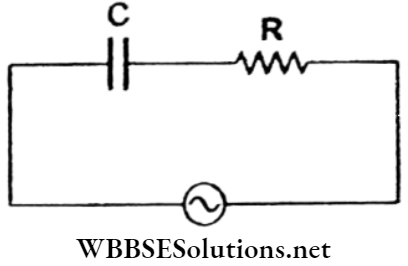
- 8 V
- 10 V
- 16 V
- None of these
Answer: 3. 16 V
Current through the series RC circuit is
⇒ \(I=\frac{V}{\sqrt{R^2+X_C^2}}\)
⇒ \(V^2=I^2 R^2+I^2 X_{\mathrm{C}}^2=V_{\mathrm{R}}^2+V_{\mathrm{C}}^2 \)
∴ \((20 \mathrm{~V})^2=(12 \mathrm{~V})^2+V_{\mathrm{C}}^2 \Rightarrow V_{\mathrm{C}}=16 \mathrm{~V}\)
Question 13. For a series LCR circuit, the power loss at resonance is
- I2ωC
- \(\frac{V^2}{\omega C}\)
- I2R
- \(\frac{V^2}{\left(\omega L-\frac{1}{\omega C}\right)}\)
Answer: 3. I2R
Power loss in a series LCR circuit is
⇒ \(P=I_{\text {rms }} V_{\text {rms }} \cos \theta=\frac{1}{2} \frac{V_0^2}{Z}=\frac{V_0^2}{2 \sqrt{R^2+\left(X_L-X_C\right)^2}}\)
At resonance, the circuit is purely resistive because XL = Xc
∴ Power loss = \(\frac{V_0^2}{2 R}=\frac{I_0^2 R}{2}=I_{\text {rms }}^2 R\)
Question 14. A 20-mH inductor, a 50-pF capacitor, and a 40-Ω resistor are connected in series across an AC voltage source V =10sin 340t. The power loss in the circuit is
- 0.67 W
- 0.89 W
- 0.76 W
- 0.51 W
Answer: 4. 0.51 W
Given, V = l0sin 340t = V0 sin ωt, R = 40 Ω, C = 50 μF, L= 20 mH.
Power loss in the circuit is
⇒ \(P=\frac{V_{\mathrm{rms}}^2}{\mathrm{Z}} \cos \theta=\frac{V_{\mathrm{rms}}^2}{\mathrm{Z}} \frac{R}{\mathrm{Z}}\)
⇒ \(\frac{\left(V_0 / \sqrt{2}\right)^2 R}{Z^2}=\frac{V_0^2 R / 2}{R^2+\left(\omega L-\frac{1}{\omega C}\right)^2}\)
Substituting the given values,
⇒ \(P=\frac{(10 \mathrm{~V})^2(40 \Omega)}{2} \cdot \frac{1}{(40 \Omega)^2+\left(340 \times 20 \times 10^{-3} \Omega-\frac{1 \Omega}{340 \times 50 \times 10^{-6}}\right)^2}\)
∴ \(\frac{100 \times 40}{2(1600+2704)} W \approx 0.5 W\).
Question 15. In an AC circuit, the potential difference across the resistance, capacitance, and inductance is 80 V, 40 V, and 100 V respectively. The power factor of this circuit is
- 0.4
- 0.8
- 0.04
- 1.0
Answer: 2. 0.8
The power factor of a series LCR circuit is expressed by,
⇒ \(\cos \theta=\frac{R}{\sqrt{R^2+\left(X_L-X_C\right)^2}}=\frac{V_R}{\sqrt{V_R^2+\left(V_L-V_C\right)^2}}\)
Given, VR = 80 V, Vc = 40 V and VL =100 V
∴ Power factor = \(\frac{80}{\sqrt{80^2+(100-40)^2}}=\frac{80}{100}=0.8\)
Question 16. Power dissipation in an LCR series circuit connected to an AC source of voltage ε is
- \(\frac{\mathcal{E}^2 R}{\left[R^2+\left(\omega L-\frac{1}{\omega C}\right)^2\right]}\)
- \(\frac{\mathcal{E}^2 R}{\left[R^2+\left(\omega L+\frac{1}{\omega C}\right)^2\right]}\)
- \(\frac{\mathcal{E}^2 \sqrt{R^2+\left(\omega L-\frac{1}{\omega C}\right)^2}}{R}\)
- \(\frac{\varepsilon^2 R^2+\left(\frac{1}{\omega C}\right)^2}{\omega L}\)
Answer: 1. \(\frac{\mathcal{E}^2 R}{\left[R^2+\left(\omega L-\frac{1}{\omega C}\right)^2\right]}\)
Power dissipation in a series LCR circuit is
⇒ \(P=I_{\mathrm{rms}} \varepsilon_{\mathrm{rms}} \cos \theta\)
∴ \(\frac{\varepsilon_{\mathrm{ms}}^2}{\mathrm{Z}} \frac{R}{\mathrm{Z}}=\frac{\varepsilon_{\mathrm{rms}}^2 R}{\mathrm{Z}^2}=\frac{\varepsilon_{\mathrm{rms}}^2 R}{\left[R^2+\left(\omega L-\frac{1}{\omega C}\right)^2\right]}\)
Question 17. A resistance R draws power P when connected to an AC source. If an inductance is now placed in series with the resistance such that the impedance of the circuit becomes Z, the power drawn will be
- \(P\left(\frac{R}{Z}\right)\)
- \(P \sqrt{\frac{R}{Z}}\)
- \(P\left(\frac{R}{Z}\right)^2\)
- P
Answer: 3. \(P\left(\frac{R}{Z}\right)^2\)
With resistance R alone in an AC circuit, the power dissipation is
⇒ \(P=\frac{V^2}{R} \Rightarrow V^2=P R\)
With inductance connected in series with a resistor, the power dissipated is
∴ \(P^{\prime}=\frac{V^2}{Z} \cdot \cos \theta=\frac{V^2}{Z} \frac{R}{Z}=(P R) \frac{R}{Z^2}=P\left(\frac{R}{Z}\right)^2\).
Question 18. In an AC circuit, the potential differences across an inductance and a resistance joined in series are respectively 16 V and 20 V. The total potential difference of the source is
- 20 V
- 25.6 V
- 31.9 V
- 53.5 V
Answer: 2. 25.6 V
The voltage across different elements in an AC circuit follows the vector addition rule. Here VR = 20 V and VL =16 V, the phase difference between them being 90°. Hence, the total potential difference is
∴ \(V=\sqrt{V_{\mathrm{R}}^2+V_{\mathrm{L}}^2}=\sqrt{(20 \mathrm{~V})^2+(16 \mathrm{~V})^2}=\sqrt{656} \mathrm{~V}=25.6 \mathrm{~V}\).
Question 19. When a 100-V DC is applied across a coil, a current of 1 A flows through it. When a 100-V AC of frequency 50 Hz is applied across the same coil, only 0.5 A flows. The inductance of the coil is
- 55 mH
- 0.55 mH
- 0.55 H
- 5.5 mH
Answer: 3. 0.55 H
In a DC circuit, = \(I=\frac{V}{R}\)
∴ \(1 \mathrm{~A}=\frac{100 \mathrm{~V}}{R} \Rightarrow R=100 \Omega\)
In an AC circuit, = \(I=\frac{V}{Z}\)
⇒ \(\frac{1}{2} A=\frac{100 \mathrm{~V}}{Z} \Rightarrow Z=200 \Omega\)
But Z2 = R2 + ω2L2 ⇒ (200 Ω)2 = (100 Ω)2 + (I00πL)2
∴ \(L=\frac{\sqrt{300 \times 100}}{100 \pi} \mathrm{H}=\frac{\sqrt{3}}{\pi} \mathrm{H}=0.55 \mathrm{H}\).
Question 20. What is the value of inductance L for which the current is maximum in a series LCR circuit with C =10 μF and to =1000 s-1?
- 1 mH
- 10 mH
- 100 mH
- Cannot be calculated unless R is known
Answer: 3. 100 mH
In a series LCR circuit, the current is maximum when the circuit is purely resistive, the net reactance is zero (current and voltage are in the same phase).
Hence, \(X_L-X_C=0 \Rightarrow \omega L=\frac{1}{\omega C}\).
inductance is
∴ \(L=\frac{1}{\omega^2 \mathrm{C}}=\frac{1}{\left(10^3 \mathrm{~s}^{-1}\right)^2(10 \mu \mathrm{F})}=\frac{1}{10} \mathrm{H}=0.1 \mathrm{H}=100 \mathrm{mH}\)
Question 21. The reactance of a capacitor of capacitance C is X. If both the frequency and capacitance are doubled then the new reactance will become
- \(\frac{x}{4}\)
- \(\frac{x}{2}\)
- X
- 2X
Answer: 1. \(\frac{x}{4}\)
Capacitive reactance is \(X=\frac{1}{\omega C}\)
∴ New reactance is X’ = \(\frac{1}{(2 \omega)(2 C)}=\frac{1}{4}\left(\frac{1}{\omega C}\right)=\frac{X}{4}\).
Question 22. In an AC circuit, the voltage (V) and the current (I) at any instance are given by
V = V0 sin cot and I- I0 sin (ωt – Φ) respectively.
The average power in the circuit over one cycle of AC is
- \(\frac{V_0 I_0}{2}\)
- \(\frac{V_0 I_0}{2} \sin \phi\)
- \(\frac{V_0 I_0}{2} \cos \phi\)
- \(V_0 I_0\)
Answer: 3. \(\frac{V_0 I_0}{2} \cos \phi\)
Average power is
∴ \(P=I_{\mathrm{rms}} V_{\mathrm{rms}} \cos \phi=\frac{I_0}{\sqrt{2}} \frac{V_0}{\sqrt{2}} \cos \phi=\frac{I_0 V_0}{2} \cos \phi\)
Question 23. A transformer having an efficiency of 90% is working on 200 V and 3 kW power supply. If the current in the secondary coil is 6 A, the voltage across the secondary coil and the current in the primary coil are respectively
- 300 V, 15 A
- 450 V, 30 A
- 450 V, 15 A
- 600 V, 15 A
Answer: 3. 450 V, 15 A
Effidency = \(\frac{\text { output power }}{\text { input power }}=90 \%=0.9\).
Primary voltage = Vp = 200 V.
Power in primary coil = 3 kW = 3000 W.
output power = 0.9 x Vp = 0.9 x 3000 W = 2700 W.
Since the current in the secondary coil is Is = 6 A,
power output = ISVS
⇒ 2700 W = (6 A)(VS) ⇒ VS = 450 V.
For current Ip the power in the primary coil = IpVp
⇒ 3000W = Ip (200V) ⇒ Ip = 15A.
| Class 11 Physics | Class 12 Maths | Class 11 Chemistry |
| NEET Foundation | Class 12 Physics | NEET Physics |
Question 24. A transformer with an efficiency of 80% works at 4 kW and 100 V. If the secondary voltage is 200 V then the primary and secondary currents are respectively
- 40 A and 16 A
- 40 A and 20 A
- 16 A and 40 A
- 20 A and 40 A
Answer: 1. 40 A and 16 A
Input power = 4000 W.
Input voltage = 100 V.
Output (secondary) voltage = 200 V.
⇒ Since efficiency = \(\eta=\frac{\text { output }}{\text { input }} \Rightarrow 0.8=\frac{\text { output }}{4000 \mathrm{~W}}\)
Power in secondary = 200 W.
For the primary circuit, 4000 W = (100 V)Ip.
primary current = Ip = 40 A.
For the secondary circuit, 3200 W = (200 V)Is.
secondary current = Is = 16 A.
Question 25. A series resonant LCR circuit has a Q-factor of 0.4. If R = 2 kΩ and C = 0.1 μF then the value of the inductance is
- 0.1 H
- 2 H
- 64 mH
- 5 H
Answer: 3. 64 mH
Q-factor of a series LCR resonant circuit is
⇒ \(Q=\frac{1}{R} \sqrt{\frac{L}{C}}\).
L = Q2R2C = (0.4)2(2000 Ω)2(0.1 X 10-6 F) = 0.064 H = 64mH.
Question 26. A wire of resistance R is connected in series with an inductor of inductance ωL. The quality factor of the RL circuit is
- \(\frac{R}{\omega L}\)
- \(\frac{\omega L}{R}\)
- \(\frac{R}{\sqrt{R^2+\omega^2 L^2}}\)
- \(\frac{\omega L}{\sqrt{R^2+\omega^2 L^2}}\)
Answer: 2. \(\frac{\omega L}{R}\)
Q-factor = \(2 \pi \frac{\text { energy stored }}{\text { energy dissipation per cycle }}\)
∴ \(=2 \pi \frac{L I_{\mathrm{rms}}^2}{\left(I_{\mathrm{ms}}^2 R\right) / f}=2 \pi \frac{L f}{R}=\frac{\omega L}{R}\).
Question 27. Which of the following combinations should be selected for better tuning of an LCR circuit used for communication?
- R = 20, L = 1.5H, C = 35 μF
- R = 25, L = 2,5H, C = 45 μF
- R = 15, L = 3.5H, C = 30 μF
- R = 25, L = 1.5H, C = 45 μF
Answer: 3. R = 15, L = 3.5H, C = 30 μF
For better and sharp tuning, the quality factor \(Q=\frac{1}{R} \sqrt{\frac{L}{C}}\) must be high. Hence, the value of R = minimum (=15 Ω), L = maximum (= 3.5 H), and C = minimum (= 30 μF). Thus, the true option is (c).
Question 28. A capacitor of capacitance 2 μF is connected to the tank circuit of an oscillator oscillating with a frequency of 1 kHz. If the current flowing in the circuit is 2 mA, the voltage across the capacitor will be
- 0.16 V
- 0.32 V
- 0.48 V
- 15.9 V
Answer: 1. 0.16 V
Voltage across die capacitor is \(V_C=I \cdot X_C=\frac{I}{2 \pi f C}\)
Substituting the values,
∴ \(V_{\mathrm{C}}=\frac{\left(2 \times 10^{-3} \mathrm{~A}\right)}{2(3.14)\left(1000 \mathrm{~s}^{-1}\right)\left(2 \times 10^{-6} \mathrm{~F}\right)}=0.16 \mathrm{~V}\).
Question 29. In an ideal parallel LC circuit, the capacitor is charged by connecting it to a DC source which is then disconnected. The current in the circuit
- Becomes zero instantaneously
- Grows monotonically
- Decays monotonically
- Oscillates instantaneously
Answer: 4. Oscillates instantaneously
A charged capacitor when connected across an inductor constitutes an oscillatory circuit in which the current oscillates instantaneously.
Question 30. Alternating current cannot be measured by a DC ammeter because
- AC cannot pass through a DC ammeter
- AC changes direction
- The average value of current for one complete cycle is zero
- DC ammeter will get damaged
Answer: 3. Average value of current for one complete cycle is zero
A DC ammeter cannot measure alternating current because the average value of AC over one complete cycle is zero.
Question 31. An LCR series combination is connected across an AC voltage source. When L is removed from the circuit, the phase difference between the voltage and the current in the circuit is \(\frac{\pi}{3}\). If instead C is removed from the circuit, the phase difference is again \(\frac{\pi}{3}\). The power factor of the circuit is
- \(\frac{1}{\sqrt{2}}\)
- \(\frac{1}{2}\)
- 1
- \(\frac{\sqrt{3}}{2}\)
Answer: 3. 1
When L is removed, the combination becomes a series RC circuit in which current leads the voltage by \(\frac{\pi}{3}\), where tan \(\frac{\pi}{3}=\frac{X_C}{R}\).
⇒ Similarly, when C is removed, the phase difference is again \(\frac{\pi}{3}\), for which for \(\frac{\pi}{3}=\frac{X_L}{R}\).
Thus, XL = Xc, and for the LCR circuit, the power factor is
∴ \(\cos \theta=\frac{R}{Z}=\frac{R}{\sqrt{R^2+\left(X_L-X_C\right)^2}}=\frac{R}{R}=1\) [∵ XL = Xc].
Question 32. With the decrease of current in the primary coil from 2 A to zero value in 0.01 s, the emf generated in the secondary coil is 1000 V. The mutual inductance of the two coils is
- 1.25 H
- 2.50 H
- 5.00 H
- 10.00 H
Answer: 3. 5.00 H
For two inductively coupled coils,
⇒ \(\phi_2=M I_1 \Rightarrow\left|\varepsilon_2\right|=\frac{d \phi_2}{d t}=M \frac{\Delta I_1}{\Delta t}\)
∴ \(1000 \mathrm{~V}=M \frac{2 \mathrm{~A}-0}{0.01 \mathrm{~s}}=M\left(200 \mathrm{~A} \mathrm{~s}^{-1}\right) \Rightarrow M=5.00\)H.
Question 33. A 220-V input is supplied to a transformer. The output circuit draws a current of 2.0 A at 440 V. If the efficiency of the transformer is 80%, the current drawn by the primary windings of the transformer is
- 3.6 A
- 2.8 A
- 2.5 A
- 5.0 A
Answer: 4. 5.0 A
Given, Vp = 220 V, Is = 2.0 A, VS = 440 V.
Output power = ISVS, = (2 A)(440 V) = 880 W.
Since Efficiency = \(\eta=0.8=\frac{\text { output watt }}{\text { input watt }}=\frac{880 \mathrm{~W}}{\text { input watt }}\)
⇒ input power = \(\frac{880 \mathrm{~W}}{0.8}=1100 \mathrm{~W}\)
But input power = IpVp = Ip(220 V) =1100 W.
∴ Primary Current = \(I_{\mathrm{p}}=\frac{1100 \mathrm{~W}}{220 \mathrm{~V}}=5.0 \mathrm{~A}\).
Question 34. A transformer is used to light a 100 W-110 V lamp from a 220-V main. If the main current is 0.5 A, the efficiency of the transformer is approximately
- 30%
- 10%
- 90%
- 50%
Answer: 3. 90%
To light the bulb,
power in secondary = Ws = 100 W.
Supply through the primary has
Vp = 220 V, Ip =0.5 A.
Input power = IpVp =(0.5 A)(220 V) =110 W.
Hence, the efficiency of the transformer is
∴ \(\eta=\frac{\text { output watt }}{\text { input watt }}=\frac{100 \mathrm{~W}}{110 \mathrm{~W}}=\frac{10}{11}=0.9=90 \%\).
Question 35. The primary and secondary coils of a transformer have 50 and 1500 turns respectively. If the magnetic flux Φ linked with the primary coil is given by Φ = Φ0 – 4t, where Φ is in Weber, t is in second, and Φ0 is a constant, the output voltage across the secondary coil is
- 90 V
- 30 V
- 120 V
- 220 V
Answer: 3. 120 V
The ratio of voltage in terms of turn ratio is given by
⇒ \(\frac{V_{\mathrm{s}}}{V_p}=\frac{N_{\mathrm{s}}}{N_{\mathrm{p}}}=\frac{1500}{50}=30\)
In the primary circuit, magnetic flux is
Φ = Φ0 + 4t.
So, the voltage in the primary circuit is
∴ \(V_{\mathrm{p}}=\left|\frac{d \phi}{d t}\right|=4 \Rightarrow V_{\mathrm{s}}=30\left(V_{\mathrm{p}}\right)=30 \times 4 \mathrm{~V}=120 \mathrm{~V}\)
Question 36. A transformer works on the principle of
- Self-induction
- Mutual induction
- Inverter
- Converter
Answer: 2. Mutual induction
In a transformer, the magnetic flux from the primary coil is linked with the secondary one and the transformer works on the principle of mutual induction.
Question 37. The quantity that remains unchanged in a transformer is
- Voltage
- Current
- Frequency
- None of these
Answer: 3. Frequency
The frequency of the input AC voltage remains the same in the primary as well as in the secondary circuit.
Question 38. The primary winding of a transformer has 500 turns whereas its secondary one has 5000 turns. The primary is connected to an AC supply of 20 V-50 Hz. The secondary will have an output of
- 2 V, 5 Hz
- 2 V, 50 Hz
- 200 V, 50 Hz
- 200 V, 500 Hz
Answer: 2. 2 V, 50 Hz
Given, Np = 500, NS = 5000, Vp = 20 V, f = 50 Hz..
⇒ Since \(\frac{V_{\mathrm{s}}}{V_{\mathrm{p}}}=\frac{N_{\mathrm{s}}}{N_{\mathrm{p}}} \text {, hence } \frac{V_{\mathrm{s}}}{20 \mathrm{~V}}=\frac{5000}{500}=10\)
∴ output voltage = VS = 200 V, but frequency = f= 50 Hz remains unchanged.
Question 39. A step-up transformer operates on a 230-V line and supplies a current of 2 A to a load. The ratio of the primary and the secondary windings is 1: 25. The current in the primary coil is
- 12.5 A
- 25 A
- 50 A
- 15 A
Answer: 3. 50 A
Given, \(V_{\mathrm{p}}=230 \mathrm{~V}, I_{\mathrm{s}}=2 \mathrm{~A}, \frac{N_{\mathrm{p}}}{N_{\mathrm{s}}}=\frac{1}{25}\).
⇒ Since, \(\frac{V_{\mathrm{p}}}{V_{\mathrm{s}}}=\frac{N_{\mathrm{p}}}{N_{\mathrm{s}}}, \text { so } \frac{230 \mathrm{~V}}{V_{\mathrm{s}}}=\frac{1}{25}\).
∴ output voltage = VS = (230 V) x 25.
Assuming 100% efficiency,
input power = output power
⇒ IpVp = IsVS
⇒ Ip(230 V) = (2 A)(230 x 25 V).
∴ current in the primary = Ip = 50 A
Question 40. The quantity that is increased in a step-down transformer is
- Voltage
- Current
- Power
- Frequency
Answer: 2. Current
In an ideal step-down transformer,
⇒ \(\frac{V_{\mathrm{s}}}{V_{\mathrm{p}}}=\frac{N_{\mathrm{s}}}{N_{\mathrm{p}}}\)
Since Ns < Np, so VS < Vp.
But VpIp = VSIs, so Is > Ip, the current is increased.
Question 41. The turn ratio of a step-up transformer is 1: 2. If a Leclanche cell of 1.5 V is connected across the input, what is the voltage across the output?
- 1.5 V .
- 0.0 V
- 3 V
- 0.75 V
Answer: 2. 0.0 V
A transformer works only with AC in which the change of magnetic flux with time induces a voltage. Therefore, with a DC source, there will be zero output in the secondary.
Question 42. A coil of inductive reactance 31 Ω. has a resistance of 8 Ω. It is placed in series with a capacitor of capacitive reactance 25 Ω. The combination is connected to an AC source of 110 V. The power factor of the circuit is
- 0.50
- 0.80
- 0.64
- 0.33
Answer: 2. 0.80
The power factor of a series LCR AC circuit is
⇒ \(\cos \phi=\frac{R}{Z}=\frac{R}{\sqrt{R^2+\left(X_L-X_C\right)^2}}\)
Given, R =8Ω, XL = 31Ω, Xc = 25 Ω.
∴ Power factor = \(\frac{8}{\sqrt{8^2+(31-25)^2}}=\frac{8}{10}=0.8\).
Question 43. In an AC circuit with voltage V and current I, the power dissipated is
- VI
- \(\frac{1}{2} V I\)
- \(\frac{1}{\sqrt{2}} V I\)
- Dependent on the phase difference between V and I
Answer: 4. Dependent on the phase difference between V and I
Power dissipation in an AC circuit is
P = Irms Vrms CosΦ.
This depends on the value of the angle Φ, which is the phase difference between the current and voltage.
Question 44. A 50-Hz AC current of crest value 1 A flows through the primary of a transformer. If the mutual inductance between the primary and the secondary is 0.5 H, the crest voltage induced in the secondary is
- 75V
- 150 V
- 100 V
- None of these
Answer: 3. 100 V
Flux Φ in the secondary coil is proportional to the current Ip in the primary.
Hence,
⇒ \(\phi_{\mathrm{s}} \propto I_{\mathrm{p}} \Rightarrow \phi_{\mathrm{s}}=M I_{\mathrm{p}}\)
Induced voltage in the secondary is
⇒ \(V_{\mathrm{s}}=\left|\frac{d \phi_{\mathrm{s}}}{d t}\right|=M \frac{\Delta I_{\mathrm{p}}}{\Delta t}\)
⇒ Hence M = \(0.5 \mathrm{H}, \frac{\Delta I_{\mathrm{p}}}{\Delta t}=\frac{1 \mathrm{~A}-(-1 \mathrm{~A})}{T / 2}=\frac{4 \mathrm{~A}}{T}=(4 \mathrm{~A}) f\)
Thus, the voltage induced in the secondary is
∴ VS = (0.5 H)(4 A)(50 s–1) =100 V.
Question 45. Consider a series AC circuit containing L = 1.0 H, C = 10 μF, and R, =100 Ω. Find the lower angular frequency corresponding to a half-power point.
- 266
- 170
- 230
- 366
Answer: 1. 266
The frequency interval between the half power points in a series LCR resonant circuit is given by
⇒ \(\Delta \omega=\omega_2-\omega_1=\frac{R}{L}\)
Since resonance frequency, \(\omega_0=\frac{1}{\sqrt{L C}}\), so
⇒ \(\omega=\omega_0 \pm \frac{R}{2 L}=\frac{1}{\sqrt{(1 \mathrm{H})\left(10^{-5} \mu \mathrm{F}\right)}} \pm \frac{100 \Omega}{2(1.0 \mathrm{H})}\)
⇒ \(=316.2 \mathrm{rad} \mathrm{s}^{-1} \pm 50 \mathrm{rad} \mathrm{s}^{-1}\)
∴ \(366.2 \mathrm{rad} \mathrm{s}^{-1} \text { and } 266.2 \mathrm{rad} \mathrm{s}^{-1}\)
Question 46. In a transformer, the number of turns in primary is 500 and that in secondary is 10. If the load resistance is 10 Ω and the voltage in the secondary circuit is 50 V then the current in the primary circuit is
- 0.2 A
- 0.3 A
- 0.4 A
- 0.1 A
Answer: 4. 0.1 A
Given, Np = 500, Ns =10, Vs = 50 V, RL =10 Ω.
Since \(\frac{V_{\mathrm{s}}}{V_{\mathrm{p}}}=\frac{N_{\mathrm{s}}}{N_{\mathrm{p}}} \Rightarrow V_{\mathrm{p}}=\frac{N_{\mathrm{p}}}{N_{\mathrm{s}}} \cdot V_{\mathrm{s}}=\frac{500}{10} \times 50 \mathrm{~V}=2500 \mathrm{~V}\)
Current in the secondary is
⇒ \(I_{\mathrm{s}}=\frac{V_{\mathrm{s}}}{R_{\mathrm{L}}}=\frac{50 \mathrm{~V}}{10 \Omega}=5 \mathrm{~A}\).
Now, input power = output power
Vp. Ip = VS . IS
current in the primary is
∴ \(I_{\mathrm{p}}=\frac{V_{\mathrm{s}} \cdot I_{\mathrm{s}}}{V_{\mathrm{p}}}=\frac{(50 \mathrm{~V})(5 \mathrm{~A})}{(2500 \mathrm{~V})}=0.1 \mathrm{~A}\)
Question 47. A transformer with turn ratio \(\frac{N_{\mathrm{p}}}{N_{\mathrm{s}}}\) = 50 is connected to a 120-V AC supply. If the resistance in the primary and secondary circuits is 1.5 kΩ and 1Ω respectively, find the power output.
- 11.4 W
- 5.76 W
- 2.3 W
- 12.4 W
Answer: 2. 5.76 W
Turn ratio is
⇒ \(\frac{N_{\mathrm{p}}}{N_{\mathrm{s}}}=50=\frac{V_{\mathrm{p}}}{V_{\mathrm{s}}}=\frac{120 \mathrm{~V}}{V_{\mathrm{s}}}\)
⇒ \(V_{\mathrm{s}}=\frac{120}{50} \mathrm{~V}\)
Since, \(R_{\mathrm{s}}=1 \Omega \text {, so } I_{\mathrm{s}}=\frac{V_{\mathrm{s}}}{R_{\mathrm{s}}}=\frac{120}{50} \mathrm{~A}\)
∴ Power output = \(I_s V_s=\left(\frac{120}{50}\right)^2 \mathrm{~W}=\frac{144}{25} \mathrm{~W}=5.76 \mathrm{~W}\).
Question 48. Find the energy stored in the inductor of an LCR circuit at resonance. Given that V =10 V, R = 10 Ω, and L =1 H.
- 2J
- 4J
- 0.5 J
- 10 J
Answer: 3. 0.5 J
At resonance, the circuit is purely resistive, and the current
⇒ \(I=\frac{V}{R}=\frac{10 \mathrm{~V}}{10 \Omega}=1 \mathrm{~A}\)
Energy in the inductor is
∴ \(U=\frac{1}{2} L I^2=\frac{1}{2}(1 \mathrm{H})(1 \mathrm{~A})^2=0.5 \mathrm{~J}\)
Question 49. A transformer consisting of 300 turns in the primary and 150 turns in the secondary gives an output power of 2.2 kW. If the current in the secondary coil is 10 A then the input voltage and current in the primary coil are
- 440 V, 5 A
- 440 V, 20 A
- 20 V, 10 A
- 220 V, 20 A
Answer: 1. 440 V, 5 A
Given, Np = 300, Ns =150.
Output power = ISVS = 2.2 kW = 2200 W.
Current in secondary is IS =10 A.
(10A)(VS) = 2200W ⇒ Vs = 220 V
⇒ \(\frac{V_{\mathrm{p}}}{V_{\mathrm{s}}}=\frac{N_{\mathrm{p}}}{N_{\mathrm{s}}} \Rightarrow \frac{V_{\mathrm{p}}}{220 \mathrm{~V}}=\frac{300}{150} \Rightarrow V_{\mathrm{p}}=440 \mathrm{~V}\).
Assuming no power loss,
⇒ \(I_{\mathrm{p}} V_{\mathrm{p}}=2200 \mathrm{~W} \Rightarrow I_{\mathrm{p}}=\frac{2200 \mathrm{~W}}{440 \mathrm{~V}}=5 \mathrm{~A}\).
Thus, the input voltage and input current are 440 V and 5 A respectively.
Question 50. An alternating voltage V(t) = 220sin l00πt volt is applied across a purely resistive load of 50 Ω. The time taken for the current to rise from half of the peak value to the peak value is
- 2.2 ms
- 5 ms
- 3.3 ms
- 7.2 ms
Answer: 3. 3.3 ms
In a resistive circuit, current and voltage are in the same phase. Thus,
I = I0 sin l00πt.
For current to increase from 0 to \(\frac{I_0}{2}\),
⇒ \(\frac{I_0}{2}=I_0 \sin 100 \pi t_1\)
⇒ \(\sin \frac{\pi}{6}=\sin 100 \pi t_1 \Rightarrow t_1=\frac{1}{600} \mathrm{~s}\)
For the current to increase from 0 to I0,
I0 = I0 sin 100 πt2
⇒ \(\sin \frac{\pi}{2}=\sin 100 \pi t_2 \Rightarrow t_2=\frac{1}{200} \mathrm{~s}\)
So, the required time interval is
∴ \(\Delta T=t_2-t_1=\left(\frac{1}{200}-\frac{1}{600}\right) \mathrm{s}=3.3 \mathrm{~ms}\).
Question 51. A series AC circuit containing an inductor (20 mH), a capacitor (120 μF), and a resistor (60 Ω) is driven by an AC source of 24 V, 50 Hz. The energy dissipated in the circuit in 60 s is
- 3.39 x 103 J
- 5.65 x 102 J
- 2.26 x 103 J
- 5.17 x 102 J
Answer: 4. 5.17 x 102 J
Energy dissipated is
E = power x time
= (Irms . Vrms Cos Φ) time
⇒ \(\frac{V_{\mathrm{rms}}^2 \times R}{\mathrm{Z}^2} t=\frac{V_{\mathrm{rms}}^2 R t}{R^2+\left(\mathrm{X}_{\mathrm{L}}-X_{\mathrm{C}}\right)^2}\)
Given, Vrms, = 24 V, R = 60Ω, t = 60 s,
XL = ωL = (100π)(20 x 10-3) O = 2π Ω,
⇒ \(X_C=\frac{1}{\omega C}=\frac{1}{100 \pi \times 120 \times 10^{-6}} \Omega=\frac{1000}{12 \pi} \Omega\)
∴ \(E=\frac{(24)^2(60)(60) \mathrm{J}}{3600+(26.5-6.28)^2}=\frac{3600 \times(24)^2}{3600+(20.3)^2} \mathrm{~J}=517.7 \mathrm{~J}=5.17 \times 10^2 \mathrm{~J}\).
Question 52. A power transmission line feeds input power at 2300 V to a stepdown transformer with its primary windings having 4000 turns. The output power is delivered at 230 V by the transformer. If the current through the primary coil is 5 A and the efficiency is 90%, the output current would be
- 45 A
- 50 A
- 25A
- 35A
Answer: 1. 45 A
Given, Vp = 2300 V, Np = 4000, VS = 230 V, Ip = 5 A.
Input power = Ip x Vp = (5 A)(2300 V) = (23 x 5 x 100) W.
Output power = \(\frac{90}{100} \times(23 \times 500) \mathrm{W}=450 \times 23 \mathrm{~W}\)
Now, ISVS = (450 x 23) W
⇒ \(I_s=\frac{(450 \times 23) \mathrm{W}}{V_s}=\frac{(450 \times 23) \mathrm{W}}{230 \mathrm{~V}}=45 \mathrm{~A}\).
Question 53. In the given circuit, R1 =10 Ω, R2 = 20 Ω, L = (√3/10) H and C =(√3/2) pF. Current through the L-R1 path is I1 and through the C-R2 path is I2. The voltage of the AC source is given by V = 200√2 sin l00t V. The phase difference between It and I2 is
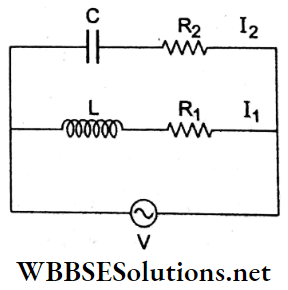
- 60°
- 0°
- 150°
- 90°
Answer: 3. 150°
Capacitive reactance is
⇒ \(X_C=\frac{1}{\omega C}=\frac{10^6}{100 \times \frac{\sqrt{3}}{2}} \Omega=\frac{20000}{\sqrt{3}} \Omega\)
Current I2 leads the voltage by where
⇒ \(\tan \phi_1=\frac{X_C}{R}=\frac{20000}{\sqrt{3} \times 20}=\frac{1000}{\sqrt{3}}\)
hence Φ1 ≈ 90° (lead).
Inductive reactance is
⇒ \(X_L=\omega L=100 \times \frac{\sqrt{3}}{10} \Omega=10 \sqrt{3} \Omega\)
Current I1 lags behind the voltage by Φ2, where
⇒ \(\tan \phi_2=\frac{X_L}{R}=\frac{10 \sqrt{3}}{10}=\sqrt{3}, \text { hence } \phi_2=60^{\circ}(\mathrm{lag})\)
Hence, a phase difference between and I2 is
∴ Φ = Φ1 – Φ2 = 90°- (-60°) =150°.
Question 54. A circuit connected to an AC source of emf ε = ε0 sin l00t with t in seconds gives a phase difference of π/4 between the emf ε and current I. Which of the following circuits will exhibit this?
- RL circuit with R =1 kΩ and L=10 mH
- RC circuit with R-1 kΩ and C =10 μF
- RL circuit with R =1 kΩ and L =1 mH
- RC circuit with R =1 kΩ and C =1 μF
Answer: 2. RC circuit with R-1 k£2 and C =10 μ F
Given, ω =100 rad s-1 and phase difference, \(\phi=\frac{\pi}{4}\)
But \(\tan \phi=\frac{X}{R}\), hence R = reactance (XL OR Xc ).
Since R = 1kΩ =1000 Ω, hence with C =10 μF,
⇒ \(X_C=\frac{1}{\omega C}=\frac{1}{100 \times 10 \times 10^{-6}}=10^3 \Omega=1 \mathrm{k} \Omega\).
This is true with option (2).
Question 55. One kilogram of water at 20 °C is heated in an electric kettle whose heating element has a mean resistance of 20Ω. The supply voltage is V = (200√2 V)sin l00πt. Ignoring heat loss by the kettle, the time taken for water to evaporate fully is close to
- 22 minutes
- 16 minutes
- 3 minutes
- 10 minutes
Answer: 1. 22 minutes
Heat absorbed by water to boil and turn into steam is
Q = mCωΔT + mL
=1 x 4200 x (100- 20) J +1 x 2250 x 103 J
= (336000 + 2250 x 103) J = 2586 x 103 J.
The energy supplied by the power source is
∴ \(p \times t=\frac{V_{\mathrm{rms}}^2}{R} t=\frac{(200)^2 t}{20} \mathrm{~J} \Rightarrow t=\frac{2586 \times 10^3 \times 20}{4 \times 10^4} \mathrm{~s} \approx 22 \mathrm{~min}\).
Question 56. An AC circuit has R = 100 Ω, C = 2 μP, and L = 80 mH, connected in series. The quality factor of the circuit is
- 0.5
- 2
- 20
- 400
Answer: 2. 2
∴ \(Q=\frac{1}{R} \sqrt{\frac{L}{C}}=\frac{1}{100 \Omega} \sqrt{\frac{80 \times 10^{-3} \mathrm{H}}{2 \times 10^{-6} \mathrm{~F}}}=2\)
Question 57. In a series LR circuit, a power of 400 W is dissipated from a 250 V-50 Hz AC source. The power factor of the circuit is 0.8. In order to bring the power factor to unity a capacitor of value C is added to. The series LR circuit. Taking C = \(\left(\frac{n}{3 \pi}\right) \mu \mathrm{F}\), the value Of n is
- 200
- 400
- 300
- 500
Answer: 2. 400
Power factor = cos θ = 0.8
⇒ \(\tan \theta=\frac{3}{4}=\frac{X_{\mathrm{L}}}{R} \Rightarrow X_{\mathrm{L}}=\frac{3}{4} R, Z=\sqrt{R^2+X_{\mathrm{L}}^2}=\frac{5 R}{4}\)
Power consumed is
⇒ \(P=I_{\mathrm{V}} V_{\mathrm{V}} \cos \theta=\frac{V_{\mathrm{V}}^2}{Z} \frac{R}{Z}\)
∴ \(R=\frac{P Z^2}{V_{\mathrm{U}}^2}=\frac{(400 \mathrm{~W})}{(250 \mathrm{~V})^2}\left(\frac{5}{4} R\right)^2 \Rightarrow R=100 \Omega\),
so XL = 75 n.
For the power factor to be, the circuit will be purely resistive, the reactance XL – Xc = 0.
⇒ \(X_C=\frac{1}{2 \pi f C}=75 \Omega\)
∴ C=\(\frac{1}{2 \pi\left(50 \mathrm{~s}^{-1}\right)(75 \Omega)}=\left(\frac{400}{3 \pi}\right) \mu \mathrm{F}\)
n = 400.
Question 58. In an LR AC circuit, the impedance is 100 Ω and the phase difference between the current and voltage is 45°. If the frequency of the voltage source is 1 kHz, what is the inductance of the coil?
- \(\frac{20 \sqrt{2}}{\pi} \mathrm{mH}\)
- \(\frac{50 \sqrt{2}}{\pi} \mathrm{mH}\)
- \(\frac{25 \sqrt{2}}{\pi} \mathrm{mH}\)
- \(25 \sqrt{2} \mathrm{mH}\)
Answer: 3. \(\frac{25 \sqrt{2}}{\pi} \mathrm{mH}\)
In an AC circuit,
∴ \(\sin \theta=\frac{X}{Z} \Rightarrow \frac{1}{\sqrt{2}}=\frac{\omega L}{Z} \Rightarrow L=\frac{Z}{\sqrt{2} \omega}=\frac{100 \Omega}{\sqrt{2} \cdot 2 \pi \times 1000}=\frac{25 \sqrt{2}}{\pi} \mathrm{mH} .\).
Question 59. In the given LCR circuit, the heat capacity of the resistor is 100 J K-1. The time t required to increase the temperature of the resistor by 10 °C is
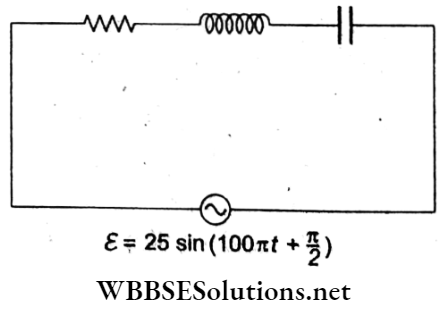
- 20 s
- 30 s
- 40 s
- 10 s
Answer: 1. 20 s
In the given AC circuit,
V0 = 25 V, Z = \(\sqrt{R^2+\left(X_L-X_C\right)^2}=\sqrt{4^2+3^2}\)Ω = 5Ω.
Average power is
⇒ \(P=\frac{1}{2} I_0 V_0 \cos \theta=\frac{V_0^2}{2 Z} \frac{R}{Z}=\frac{(25 \mathrm{~V})^2}{2(5 \Omega)^2} \cdot 4 \Omega=50 \mathrm{~W}\)
Heat absorbed by the resistor is
H = power x t = (100 J K-1)(10 K) =1000 J
∴ \(t=\frac{H}{\text { power }}=\frac{1000 \mathrm{~J}}{50 \mathrm{~J} \mathrm{~s}^{-1}}=20 \mathrm{~s}\).
Question 60. The switch S in the LR circuit is closed at f = 0. Find the time when the energy stored in the inductor becomes 1/n times the maximum energy stored in it during the growth of the current.
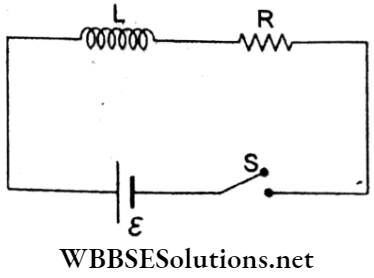
- \(\frac{L}{R} \ln \left(\frac{\sqrt{n}}{\sqrt{n}+1}\right)\)
- \(\frac{L}{R} \ln \left(\frac{\sqrt{n}}{\sqrt{n}-1}\right)\)
- \(\frac{L}{R} \ln \left(\frac{\sqrt{n}+1}{\sqrt{n}}\right)\)
- \(\frac{L}{R} \ln \left(\frac{\sqrt{n}-1}{\sqrt{n}}\right)\)
Answer: 2. \(\frac{L}{R} \ln \left(\frac{\sqrt{n}}{\sqrt{n}-1}\right)\)
The maximum energy stored in the inductor is
⇒ \(U_0=\frac{1}{2} L I_0^2\)
Current growth is
⇒ \(I=I_0\left(1-e^{-\frac{R}{L} t}\right) \Rightarrow \frac{1}{n}\left(\frac{1}{2} L I_0^2\right)=\frac{1}{2} L I_0^2\left(1-e^{-\frac{R}{L} t}\right)^2\)
∴ \(\frac{1}{\sqrt{n}}=1-e^{-\frac{R}{L} t} \Rightarrow e^{\frac{R}{L} t}=\frac{\sqrt{n}}{\sqrt{n}-1} \Rightarrow t=\frac{L}{R} \ln \left(\frac{\sqrt{n}}{\sqrt{n}-1}\right)\).
Question 61. In a series LCR circuit, the rms voltages measured across the inductor L, the capacitor C, and the resistor R are found to be in the ratio VL: Vc: VR = 1: 2: 3. If the rms voltage of the AC source is 100 V then VR is close to
- 50V
- 70V
- 90V
- 100V
Answer: 2. 70V
Let VL =V, Vc = 2V and VR = 3V.
net voltage, VS = \(\sqrt{V_{\mathrm{R}}^2+\left(V_{\mathrm{C}}-V_{\mathrm{L}}\right)^2}=\sqrt{9 V^2+V^2}=\sqrt{10 V^2}=\sqrt{10} V\)
Given that supply voltage, VS =100 V
⇒ \(\sqrt{10} \mathrm{~V}=100 \mathrm{~V} \Rightarrow V=\frac{100}{\sqrt{10}} \mathrm{~V}\)
∴ \(V_{\mathrm{R}}=3 \mathrm{~V}=3\left(\frac{100}{\sqrt{10}}\right) \mathrm{V}=94.8 \mathrm{~V} \approx 90 \mathrm{~V}\)
Question 62. A 40-μF capacitor is connected to a 200-V, 50-Hz AC source. The rms value of the current in the circuit is nearly
- 2.05 A
- 2.5 A
- 25.1 A
- 1.7 A
Answer: 2. 2.5 A
Given, Vrms = 200 V, C = 40 x 106 F, and ω = 2πf = I00π rad s-1.
Capacitive reactance = \(X_C=\frac{1}{\omega C}\)
The RMS value of the current is
⇒ \(I_{\mathrm{rms}}=\frac{V_{\mathrm{rms}}}{X_{\mathrm{C}}}=V_{\mathrm{rms}} \cdot \omega \mathrm{C}\)
(200 V)(100π rad s-1)(40 x l0-6 F)
= (O.8)(3.14) A = 2.51 A.
